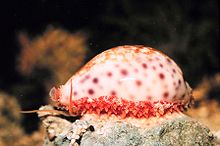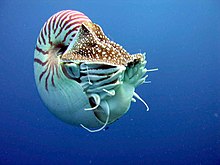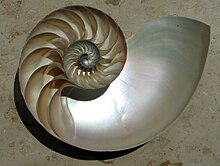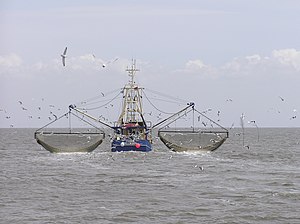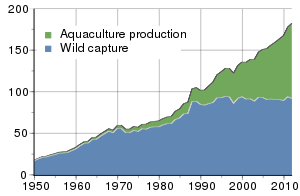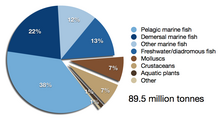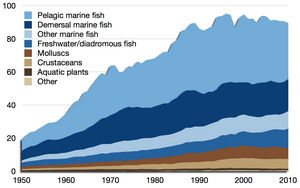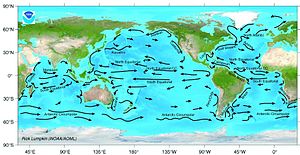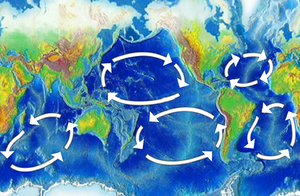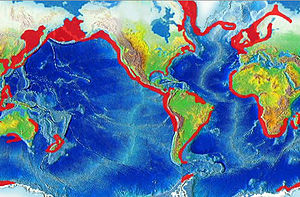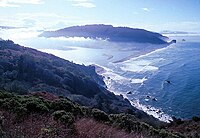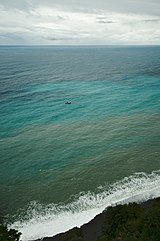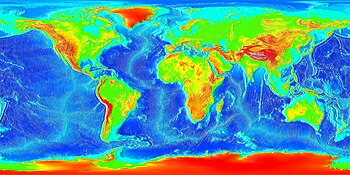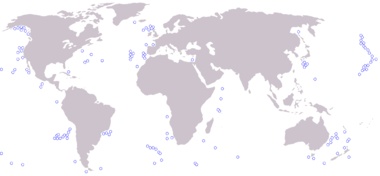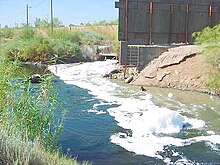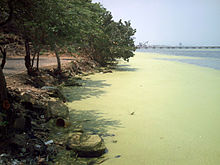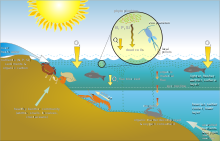Diversity and variability of shells of molluscs on display.
Variety of Mollusc shells (gastropods, snails and seashells).
Closed and open shells of a marine bivalve, Petricola pholadiformis. A bivalve shell is composed of two hinged valves which are joined by a ligament.
Four views of a shell of the land snail Arianta arbustorum
The mollusc (or mollusk[spelling 1]) shell is typically a calcareous exoskeleton which encloses, supports and protects the soft parts of an animal in the phylum Mollusca, which includes snails, clams, tusk shells, and several other classes. Not all shelled molluscs live in the sea; many live on the land and in freshwater.
The ancestral mollusc is thought to have had a shell, but this
has subsequently been lost or reduced on some families, such as the
squid, octopus, and some smaller groups such as the caudofoveata and solenogastres.
Today, over 100,000 living species bear a shell; there is some dispute
as to whether these shell-bearing molluscs form a monophyletic group
(conchifera) or whether shell-less molluscs are interleaved into their
family tree.
Malacology, the scientific study of molluscs as living organisms, has a branch devoted to the study of shells, and this is called conchology—although
these terms used to be, and to a minor extent still are, used
interchangeably, even by scientists (this is more common in Europe).
Within some species of molluscs, there is often a wide degree of variation in the exact shape, pattern, ornamentation, and color of the shell.
Formation
The giant clam (Tridacna gigas) is the largest extant species of bivalve. The mantle is visible between the open valves
A mollusc shell is formed, repaired and maintained by a part of the anatomy called the mantle.
Any injuries to or abnormal conditions of the mantle are usually
reflected in the shape and form and even color of the shell. When the
animal encounters harsh conditions that limit its food supply, or
otherwise cause it to become dormant for a while, the mantle often
ceases to produce the shell substance. When conditions improve again and
the mantle resumes its task, a "growth line" is produced.
The mantle edge secretes a shell which has two components. The
organic constituent is mainly made up of polysaccharides and
glycoproteins;
its composition may vary widely: some molluscs employ a wide range of
chitin-control genes to create their matrix, whereas others express just
one, suggesting that the role of chitin in the shell framework is
highly variable; it may even be absent in monoplacophora. This organic framework controls the formation of calcium carbonate crystals (never phosphate, with the questionable exception of Cobcrephora),
and dictates when and where crystals start and stop growing, and how
fast they expand; it even controls the polymorph of the crystal
deposited, controlling positioning and elongation of crystals and preventing their growth where appropriate.
The shell formation requires certain biological machinery. The
shell is deposited within a small compartment, the extrapallial space,
which is sealed from the environment by the periostracum,
a leathery outer layer around the rim of the shell, where growth
occurs. This caps off the extrapallial space, which is bounded on its
other surfaces by the existing shell and the mantle.
The periostracum acts as a framework from which the outer layer of
carbonate can be suspended, but also, in sealing the compartment, allows
the accumulation of ions in concentrations sufficient for
crystallization to occur. The accumulation of ions is driven by ion
pumps packed within the calcifying epithelium.
Calcium ions are obtained from the organism's environment through the
gills, gut and epithelium, transported by the haemolymph ("blood") to
the calcifying epithelium, and stored as granules within or in-between
cells ready to be dissolved and pumped into the extrapallial space when
they are required.
The organic matrix forms the scaffold that directs crystallization, and
the deposition and rate of crystals is also controlled by hormones
produced by the mollusc.
Because the extrapallial space is supersaturated, the matrix could be
thought of as impeding, rather than encouraging, carbonate deposition;
although it does act as a nucleating point for the crystals and controls
their shape, orientation and polymorph, it also terminates their growth
once they reach the necessary size. Nucleation is endoepithelial in Neopilina and Nautilus, but exoepithelial in the bivalves and gastropods.
The formation of the shell involves a number of genes and
transcription factors. On the whole, the transcription factors and
signalling genes are deeply conserved, but the proteins in the secretome
are highly derived and rapidly evolving. engrailed serves to demark the edge of the shell field; dpp controls the shape of the shell, and Hox1 and Hox4 have been implicated in the onset of mineralization. In gastropod embryos, Hox1 is expressed where the shell is being accreted; however no association has been observed between Hox genes and cephalopod shell formation. Perlucin increases the rate at which calcium carbonate precipitates to form a shell when in saturated seawater; this protein is from the same group of proteins (C-type lectins)
as those responsible for the formation of eggshell and pancreatic stone
crystals, but the role of C-type lectins in mineralization is unclear. Perlucin operates in association with Perlustrin, a smaller relative of lustrin A, a protein responsible for the elasticity of organic layers that makes nacre so resistant to cracking. Lustrin A bears remarkable structural similarity to the proteins involved in mineralization in diatoms – even though diatoms use silica, not calcite, to form their tests!
Development
Mollusc shells in Manchester Museum
The shell-secreting area is differentiated very early in embryonic
development. An area of the ectoderm thickens, then invaginates to
become a "shell gland". The shape of this gland is tied to the form of
the adult shell; in gastropods, it is a simple pit, whereas in bivalves,
it forms a groove which will eventually become the hinge line between
the two shells, where they are connected by a ligament. The gland subsequently evaginates in molluscs that produce an external shell.
Whilst invaginated, a periostracum - which will form a scaffold for the
developing shell - is formed around the opening of the invagination,
allowing the deposition of the shell when the gland is everted.
A wide range of enzymes are expressed during the formation of the
shell, including carbonic anhydrase, alkaline phosphatase, and
DOPA-oxidase (tyrosinase)/peroxidase.
The form of the molluscan shell is constrained by the organism's
ecology. In molluscs whose ecology changes from the larval to adult
form, the morphology of the shell also undergoes a pronounced
modification at metamorphosis.
The larval shell may have a completely different mineralogy to the
adult conch, perhaps formed from amorphous calcite as opposed to an
aragonite adult conch.
In those shelled molluscs that have indeterminate growth,
the shell grows steadily over the lifetime of the mollusc by the
addition of calcium carbonate to the leading edge or opening. Thus the
shell gradually becomes longer and wider, in an increasing spiral shape,
to better accommodate the growing animal inside. The shell thickens as
it grows, so that it stays proportionately strong for its size.
Secondary loss
The
loss of a shell in the adult form of some gastropods is achieved by the
discarding of the larval shell; in other gastropods and in cephalopods,
the shell is lost or demineralized by the resorption of its carbonate
component by the mantle tissue.
Shell proteins
Hundreds of soluble and insoluble
proteins control shell formation. They are secreted into the
extrapallial space by the mantle, which also secretes the glycoproteins,
proteoglycans, polysaccharides and chitin that make up the organic
shell matrix. Insoluble proteins tend to be thought of as playing a more important/major role in crystallization control. The organic matrix of shells tends to consist of β-chitin and silk fibroin. Perlucin encourages carbonate deposition, and is found at the interface of the chitinous and aragonitic layer in some shells.
An acidic shell matrix appears to be essential to shell formation, in
the cephalopods at least; the matrix in the non-mineralized squid gladius is basic.
In oysters and potentially most molluscs, the nacreous layer has
an organic framework of the protein MSI60, which has a structure a
little like spider silk and forms sheets; the prismatic layer uses MSI31 to construct its framework. This too forms beta-pleated sheets.
Since acidic amino acids, such as aspartic acid and glutamic acid, are
important mediators of biomineralization, shell proteins tend to be rich
in these amino acids.
Aspartic acid, which can make up up to 50% of shell framework proteins,
is most abundant in calcitic layers, and also heavily present in
aragonitic layers. Proteins with high proportions of glutamic acid are
usually associated with amorphous calcium carbonate.
The soluble component of the shell matrix acts to inhibit
crystallization when in its soluble form, but when it attaches to an
insoluble substrate, it permits the nucleation of crystals. By switching
from a dissolved to an attached form and back again, the proteins can
produce bursts of growth, producing the brick-wall structure of the
shell.
Chemistry
The
formation of a shell in molluscs appears to be related to the secretion
of ammonia, which originates from urea. The presence of an ammonium ion
raises the pH of the extrapallial fluid, favouring the deposition of
calcium carbonate. This mechanism has been proposed not only for
molluscs, but also for other unrelated mineralizing lineages.
Structure
Precious Wentletrap: the spiral shell of Epitonium scalare sea snail.
The calcium carbonate layers in a shell are generally of two types:
an outer, chalk-like prismatic layer and an inner pearly, lamellar or
nacreous layer. The layers usually incorporate a substance called conchiolin, often in order to help bind the calcium carbonate crystals together. Conchiolin is composed largely of quinone-tanned proteins.
The periostracum and prismatic layer are secreted by a marginal
band of cells, so that the shell grows at its outer edge. Conversely,
the nacreous layer is derived from the main surface of the mantle.
Some shells contain pigments which are incorporated into the
structure. This is what accounts for the striking colors and patterns
that can be seen in some species of seashells, and the shells of some tropical land snails. These shell pigments sometimes include compounds such as pyrroles and porphyrins.
Shells are almost always composed of polymorphs of calcium carbonate
- either calcite or aragonite. In many cases, such as the shells of
many of the marine gastropods, different layers of the shell are
composed of calcite and aragonite. In a few species which dwell near
hydrothermal vents, iron sulfide is used to construct the shell. Phosphate is never utilised by molluscs, with the exception of Cobcrephora, whose molluscan affinity is uncertain.
Shells are composite materials of calcium carbonate (found either as calcite or aragonite)
and organic macromolecules (mainly proteins and polysaccharides).
Shells can have numerous ultrastructural motifs, the most common being
crossed-lamellar (aragonite), prismatic (aragonite or calcite),
homogeneous (aragonite), foliated (aragonite) and nacre (aragonite). Although not the most common, nacre is the most studied type of layer.
Size
In most
shelled molluscs, the shell is large enough for all of the soft parts to
be retracted inside when necessary, for protection from predation or
from desiccation. However, there are many species of gastropod mollusc
in which the shell is somewhat reduced or considerably reduced, such
that it offers some degree of protection only to the visceral mass, but
is not large enough to allow the retraction of the other soft parts.
This is particularly common in the opisthobranchs and in some of the pulmonates, for example in the semi-slugs.
Some gastropods have no shell at all, or only an internal shell
or internal calcareous granules, and these species are often known as slugs. Semi-slugs are pulmonate slugs with a greatly reduced external shell which is in some cases partly covered by the mantle.
Shape
The shape of the molluscan shell is controlled both by transcription factors (such as engrailed and decapentaplegic)
and by developmental rate. The simplification of a shell form is
thought to be relatively easily evolved, and many gastropod lineages
have independently lost the complex coiled shape. However, re-gaining
the coiling requires many morphological modifications and is much rarer.
Despite this, it can still be accomplished; it is known from one
lineage that was uncoiled for at least 20 million years, before
modifying its developmental timing to restore the coiled morphology.
In bivalves at least, the shape does change through growth, but
the pattern of growth is constant. At each point around the aperture of
the shell, the rate of growth remains constant. This results in
different areas growing at different rates, and thus a coiling of the
shell and a change in its shape - its convexity, and the shape of the
opening - in a predictable and consistent fashion.
The shape of the shell has an environmental as well as a genetic
component; clones of gastropods can exert different shell morphologies.
Indeed, intra-species variation can be many times larger than
inter-species variation.
A number of terms are used to describe molluscan shell shape; in
the univalved molluscs, endogastric shells coil backwards (away from the
head), whereas exogastric shells coil forwards; the equivalent terms in bivalved molluscs are opisthogyrate and prosogyrate respectively.
Nacre
Nacre,
commonly known as mother of pearl, forms the inner layer of the shell
structure in some groups of gastropod and bivalve molluscs, mostly in
the more ancient families such as top snails (Trochidae), and pearl oysters (Pteriidae). Like the other calcareous layers of the shell, the nacre is created by the epithelial cells (formed by the germ layer ectoderm) of the mantle tissue.
However, nacre does not seem to represent a modification of other shell types, as it uses a distinct set of proteins.
Evolution
The fossil record shows that all molluscan classes evolved some 500 million years ago
from a shelled ancestor looking something like a modern
monoplacophoran, and that modifications of the shell form ultimately led
to the formation of new classes and lifestyles.
However, a growing body of molecular and biological data indicate that
at least certain shell features have evolved many times, independently.
The nacreous layer of shells is a complex structure, but rather than
being difficult to evolve, it has in fact arisen many times
convergently.
The genes used to control its formation vary greatly between taxa:
under 10% of the (non-housekeeping) genes expressed in the shells that
produce gastropod nacre are also found in the equivalent shells of
bivalves: and most of these shared genes are also found in mineralizing
organs in the deuterostome lineage.
The independent origins of this trait are further supported by
crystallographic differences between clades: the orientation of the axes
of the deposited aragonite 'bricks' that make up the nacreous layer is
different in each of the monoplacophora, gastropods and bivalves.
Mollusc shells (especially those formed by marine species) are
very durable and outlast the otherwise soft-bodied animals that produce
them by a very long time (sometimes thousands of years even without
being fossilized). Most shells of marine molluscs fossilize rather
easily, and fossil mollusc shells date all the way back to the Cambrian period. Large amounts of shell sometimes forms sediment, and over a geological time span can become compressed into limestone deposits.
Most of the fossil record of molluscs consists of their shells,
since the shell is often the only mineralised part of a mollusc (however
also see Aptychus and operculum). The shells are usually preserved as calcium carbonate – usually any aragonite is pseudomorphed with calcite.
Aragonite can be protected from recrystalization if water is kept away
by carbonaceous material, but this did not accumulate in sufficient
quantity until the Carboniferous; consequently aragonite older than the
Carboniferous is practically unknown: but the original crystal structure
can sometimes be deduced in fortunate circumstances, such as if an alga
closely encrusts the surface of a shell, or if a phosphatic mould
quickly forms during diagenesis.
The shell-less aplacophora have a chitinous cuticle that has been
likened to the shell framework; it has been suggested that tanning of
this cuticle, in conjunction with the expression of additional proteins,
could have set the evolutionary stage for the secretion of a calcareous
shell in an aplacophoran-like ancestral mollusc.
The molluscan shell has been internalized in a number of
lineages, including the coleoid cephalopods and many gastropod lineages.
Detorsion
of gastropods results in an internal shell, and can be triggered by
relatively minor developmental modifications such as those induced by
exposure to high platinum concentrations.
Pattern formation
The pattern formation processes in mollusc shells have been modeled successfully using one-dimensional reaction-diffusion systems, in particular the Gierer-Meinhardt system which leans heavily on the Turing model.
Varieties
Monoplacophora
The
nacreous layer of monoplacophoran shells appears to have undergone some
modification. Whilst normal nacre, and indeed part of the nacreous
layer of one monoplacophoran species (Veleropilina zografi), consists of "brick-like" crystals of aragonite, in monoplacophora these bricks are more like layered sheets. The c-axis is perpendicular to the shell wall, and the a-axis
parallel to the growth direction. This foliated aragonite is presumed
to have evolved from the nacreous layer, with which it has historically
been confused, but represents a novelty within the molluscs.
Chitons
The chiton Tonicella lineata, anterior end towards the right
Gastropods
The marine gastropod Cypraea chinensis, the Chinese cowry, showing partially extended mantle
In some marine genera, during the course of normal growth the animal
undergoes periodic resting stages where the shell does not increase in
overall size, but a greatly thickened and strengthened lip is produced
instead. When these structures are formed repeatedly with normal growth
between the stages, evidence of this pattern of growth is visible on the
outside of the shell, and these unusual thickened vertical areas are
called varices, singular "varix". Varices are typical in some marine gastropod families, including the Bursidae, Muricidae, and Ranellidae.
Finally, gastropods with a determinate growth pattern may create a
single and terminal lip structure when approaching maturity, after
which growth ceases. These include the cowries (Cypraeidae) and helmet shells (Cassidae), both with in-turned lips, the true conchs (Strombidae) that develop flaring lips, and many land snails that develop tooth structures or constricted apertures upon reaching full size.
Cephalopods
Nautilus belauensis is one of only 6 extant cephalopod species which have an external shell
Nautiluses are the only extant cephalopods which have an external shell. Cuttlefish, squid, spirula, vampire squid, and cirrate octopuses have small internal shells. Females of the octopus genus Argonauta
secrete a specialised paper-thin eggcase in which they partially
reside, and this is popularly regarded as a "shell", although it is not
attached to the body of the animal.
Bivalves
The shell of the Bivalvia is composed of two parts, two valves which are hinged together and joined by a ligament.
Scaphopods
The shell of many of the scaphopods ("tusk shells") resembles a miniature elephant's tusk in overall shape, except that it is hollow, and is open at both ends.
Damage to shells in collections
As
a structure made primarily of calcium carbonate, mollusc shells are
vulnerable to attack by acidic fumes. This can become a problem when
shells are in storage or on display and are in the proximity of
non-archival materials, see Byne's disease.








